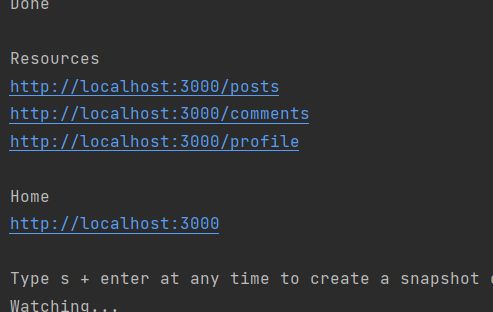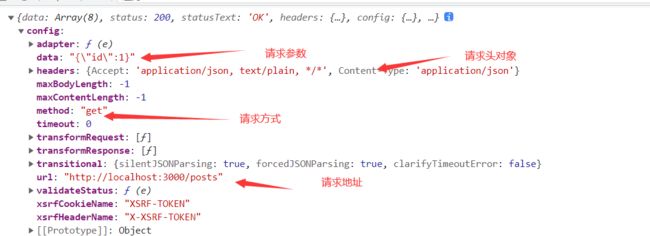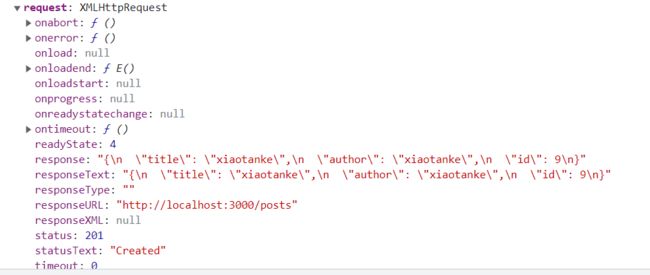axios 异步请求,配置环境,请求配置,响应配置
axios 异步请求学习笔记
Axios 是一个基于promise网络请求库,作用于node.js和浏览器中,它是 isomorphic 的(即同一套代码可以运行在浏览器和node.js中)。在服务端它使用原生node.js http模块, 而在客户端 (浏览端) 则使用XMLHttpRequests。
1、json-server的安装
这个用于请求服务器建立,通过请求获取数据。
- 使用npm命令安装
npm install -g json-server
- 在项目的根目录下创建一个db.json,用于伪装数据
{
"posts": [
{ "id": 1, "title": "json-server", "author": "typicode" }
],
"comments": [
{ "id": 1, "body": "some comment", "postId": 1 }
],
"profile": { "name": "typicode" }
}
- 启动json-server,使用命令
json-server --watch db.json
- 通过它提供的访问路劲进行访问,支持Restful风格的访问。
2、安装axios
- 使用npm安装,通常在项目使用这个方式。
npm install axios
- 通过引入在线的CDN。
<script src="https://unpkg.com/axios/dist/axios.min.js">script>
3、axios的基本使用
3.1、发送Get请求
// 发出get请求
btn[0].onclick = function () {
axios.get("http://localhost:3000/posts", // 第一个参数是请求的地址
{
id: 2, // 第二个参数是请求携带的参数,通常以对象传入
}
).then(function (response) { // 请求成功的回调函数,返回数据会封装一个promise对象
console.log(response);
}).catch(error => { // 请求失败的回调函数,返回的数据会封装一个promise对象
console.log(error);
});
};
3.2、发送Post请求
btn[1].onclick = function () {
axios.post("http://localhost:3000/posts", // 第一个参数是请求的地址
{
"title": "xiaotanke",
"author": "xiaotanke" // 第二个参数是请求携带的参数,通常以对象传入
}
).then(response => { // 请求成功的回调函数,返回数据会封装一个promise对象
console.log(response);
}).catch(function (error) { // 请求失败的回调函数,返回的数据会封装一个promise对象
console.log(error)
});
};
3.3、通过配置axios发出请求
// 通过配置axios进行请求
btn[2].onclick = function () {
// 进行请求,通过配置axios进行请求
axios({
method: "GET", // 请求的方式,如果不指定方式,默认是GET请求
url: "http://localhost:3000/posts", // 请求的地址
data: { // 请求的参数,通常是对象
id: 1
}
}).then(response => { // 请求成功的回调函数,返回数据会封装一个promise对象
console.log(response);
}).catch(error => { // 请求失败的回调函数,返回的数据会封装一个promise对象
console.log(error);
});
};
4、response 响应对象
如果请求成功,在响应成功的回调函数中会封装一个promise对象,这个对象中封装了请求的信息,响应数据的信息,响应头信息,封装的xmlHttpRequest信息等。
- config属性:是response的一个属性,这个属性值是一个对象
- data属性:服务器响应的数据,它会将返回的数据自动转换成一个对象。
- header属性:一些响应头的信息。
- request属性:封装的一个XMLHttpRequest对象。
- status属性:响应的状态码。
5、请求配置
{
// `url` 是用于请求的服务器 URL
url: '/user',
// `method` 是创建请求时使用的方法,默认是get方式
method: 'get',
// `baseURL` 将自动加在 `url` 前面,除非 `url` 是一个绝对 URL。
// 它可以通过设置一个 `baseURL` 便于为 axios 实例的方法传递相对 URL
baseURL: 'https://some-domain.com/api/',
// `transformRequest` 允许在向服务器发送前,修改请求数据
// 只能用在 'PUT', 'POST' 和 'PATCH' 这几个请求方法
// 后面数组中的函数必须返回一个字符串,或 ArrayBuffer,或 Stream
transformRequest: [function (data, headers) {
// 对 data 进行任意转换处理
return data;
}],
// `transformResponse` 在传递给 then/catch 前,允许修改响应数据
transformResponse: [function (data) {
// 对 data 进行任意转换处理
return data;
}],
// `headers` 是即将被发送的自定义请求头
headers: {'X-Requested-With': 'XMLHttpRequest'},
// `params` 是即将与请求一起发送的 URL 参数
// 必须是一个无格式对象(plain object)或 URLSearchParams 对象
// 就是在url后面追加参数,值是一个对象
params: {
ID: 12345
},
// `paramsSerializer` 是一个负责 `params` 序列化的函数
// (e.g. https://www.npmjs.com/package/qs, http://api.jquery.com/jquery.param/)
paramsSerializer: function(params) {
return Qs.stringify(params, {arrayFormat: 'brackets'})
},
// `data` 是作为请求主体被发送的数据
// 它可以有两个方式:字符串,对象
// 如果是字符串,它就直接将字符串传递;如果是对象它会将对象装换成json字符串,然后传递。
data: {
firstName: 'Fred'
},
// `timeout` 指定请求超时的毫秒数(0 表示无超时时间)
// 如果请求话费了超过 `timeout` 的时间,请求将被中断
timeout: 1000,
// `withCredentials` 表示跨域请求时是否需要使用cookie
// false不携带,true携带
withCredentials: false, // default,不携带
// `adapter` 允许自定义处理请求,以使测试更轻松
// 返回一个 promise 并应用一个有效的响应 (查阅 [response docs](#response-api)).
adapter: function (config) {
/* ... */
},
// `auth` 表示应该使用 HTTP 基础验证,并提供凭据
// 这将设置一个 `Authorization` 头,覆写掉现有的任意使用 `headers` 设置的自定义 `Authorization`头
auth: {
username: 'janedoe',
password: 's00pers3cret'
},
// `responseType` 表示服务器响应的数据类型,可以是 'arraybuffer', 'blob', 'document', 'json', 'text', 'stream'
responseType: 'json', // default,默认为json
// `responseEncoding` indicates encoding to use for decoding responses
// Note: Ignored for `responseType` of 'stream' or client-side requests
responseEncoding: 'utf8', // default
// `xsrfCookieName` 是用作 xsrf token 的值的cookie的名称
xsrfCookieName: 'XSRF-TOKEN', // default
// `xsrfHeaderName` is the name of the http header that carries the xsrf token value
xsrfHeaderName: 'X-XSRF-TOKEN', // default
// `onUploadProgress` 允许为上传处理进度事件
onUploadProgress: function (progressEvent) {
// Do whatever you want with the native progress event
},
// `onDownloadProgress` 允许为下载处理进度事件
onDownloadProgress: function (progressEvent) {
// 对原生进度事件的处理
},
// `maxContentLength` 定义允许的响应内容的最大尺寸,单位字节
maxContentLength: 2000,
// `validateStatus` 定义对于给定的HTTP 响应状态码是 resolve 或 reject promise 。如果 `validateStatus` 返回 `true` (或者设置为 `null` 或 `undefined`),promise 将被 resolve; 否则,promise 将被 rejecte
validateStatus: function (status) {
return status >= 200 && status < 300; // default
},
// `maxRedirects` 定义在 node.js 中 follow 的最大重定向数目
// 如果设置为0,将不会 follow 任何重定向
maxRedirects: 5, // default
// `socketPath` defines a UNIX Socket to be used in node.js.
// e.g. '/var/run/docker.sock' to send requests to the docker daemon.
// Only either `socketPath` or `proxy` can be specified.
// If both are specified, `socketPath` is used.
socketPath: null, // default
// `httpAgent` 和 `httpsAgent` 分别在 node.js 中用于定义在执行 http 和 https 时使用的自定义代理。允许像这样配置选项:
// `keepAlive` 默认没有启用
httpAgent: new http.Agent({ keepAlive: true }),
httpsAgent: new https.Agent({ keepAlive: true }),
// 'proxy' 定义代理服务器的主机名称和端口
// `auth` 表示 HTTP 基础验证应当用于连接代理,并提供凭据
// 这将会设置一个 `Proxy-Authorization` 头,覆写掉已有的通过使用 `header` 设置的自定义 `Proxy-Authorization` 头。
proxy: {
host: '127.0.0.1',
port: 9000,
auth: {
username: 'mikeymike',
password: 'rapunz3l'
}
},
// `cancelToken` 指定用于取消请求的 cancel token
// (查看后面的 Cancellation 这节了解更多)
cancelToken: new CancelToken(function (cancel) {
})
}
axios的默认配置:
可以通过axios.defaults.请求配置名 = 值,这个格式来设置默认的请求配置,例如以下:
axios.defaults.baseURL = 'http://localhost/'; // 可以配置默认的baseURL,将这段url会添加的请求路径中
6、axios创建实例进行请求
通过创建axios实例设置不同的配置,可以对多个服务器进行发出请求。创建的axios实例的用法和axios本身这个对象一样。
// 创建一个axios实例
var myaxios = axios.create({
baseURL: "http://localhost:3000", // 设置这个实例的默认配置
timeOut: 3000
});
// 通过实例对象进行请求
myaxios.get("/posts",{
params: {
id: 1
}
}).then(response => {
console.log(response.data[0]);
});var myaxios = axios.create({
baseURL: "http://localhost",
timeOut: 3000
});
7、取消请求
如果用户疯狂点击一个请求的时候,但是上一个请求还未响应,这样就会造成服务器很大的压力,这就需要在用户多次点击请求的时候取消掉用户的上一次请求。
var CancelToken = axios.CancelToken;
// 通过配置axios进行请求
var requested = null;
btn[2].onclick = function () {
// 在请求前判断是否还存在请求
if(requested !== null){
// 将这个请求取消掉
requested();
}
// 进行请求,通过配置axios进行请求
axios({
method: "get", // 请求的方式
url: "http://localhost:3000/posts", // 请求的地址
data: { // 请求的参数,通常是对象
id: 1
},
cancelToken: new CancelToken(function executor(c) {
// executor 函数接收一个 cancel 函数作为参数
requested = c;
})
}).then(response => { // 请求成功的回调函数,返回数据会封装一个promise对象
// 如果请求成功后,就需要将requested置为null
requested = null;
console.log(response);
}).catch(error => { // 请求失败的回调函数,返回的数据会封装一个promise对象
console.log(error);
});
};




